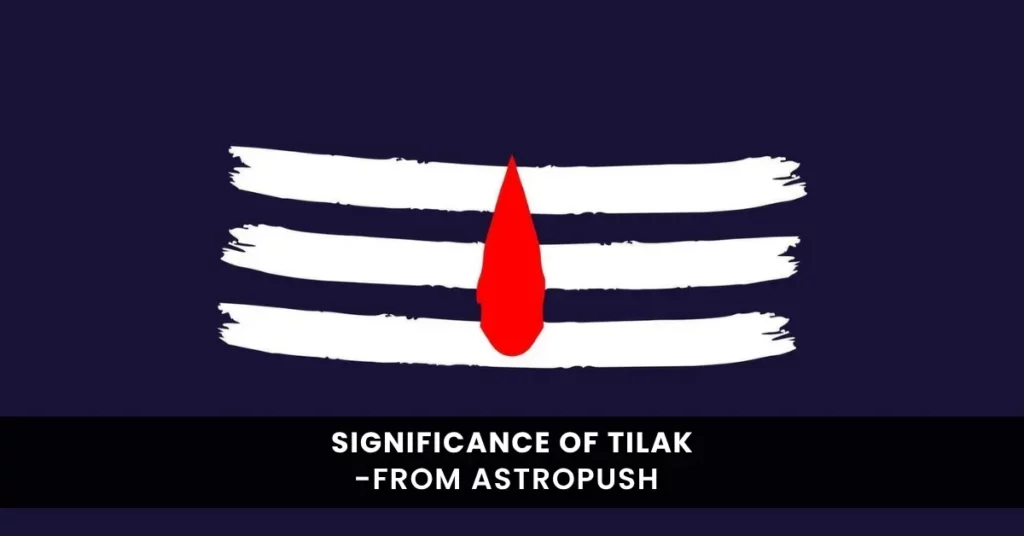The “Significance of Tilak” holds a special place in Indian culture, where it symbolizes religious and spiritual importance. People often apply tilak as a mark on the forehead, carrying deep cultural, religious, and astrological meanings. It serves not just as a decorative mark but as a representation of blessings, protection, and divine guidance. Ancient Indian traditions have passed down the significance of tilak through generations, symbolizing an individual’s alignment with spiritual beliefs and practices.
Various religious groups, especially Hindus, wear tilak as part of daily rituals, festive occasions, and religious ceremonies. People view its application as more than a tradition; it connects deeply to one’s faith, signifying devotion and purity. Over time, tilak has gained prominence in not only religious contexts but also social, spiritual, and even astrological aspects of life. Let’s explore the “Significance of Tilak” in greater depth.
Historical Origins of the Tilak
The roots of tilak date back to ancient Vedic times when rituals and customs were an integral part of life. The scriptures mention the application of tilak as a sacred act that marks the individual as a devotee of the divine. In early Hindu traditions, priests and spiritual leaders would apply tilak on the foreheads of those seeking blessings and protection from deities.
The tilak was initially used to mark the beginning of a prayer or ritual, signifying the devotee’s surrender to God. Over time, the practice evolved, with different colors and shapes of tilak symbolizing various sects and beliefs within Hinduism. For instance, a red or saffron-colored tilak is often associated with Vaishnavism (devotees of Lord Vishnu), while a white ash tilak (Vibhuti) represents the followers of Shaivism (devotees of Lord Shiva).
This practice was not just limited to men. Women also applied tilak, usually in the form of a bindi, to symbolize their marital status and spiritual inclination. Tilak became a universal symbol of purity, protection, and devotion across different segments of society.
Spiritual Significance of Tilak
The spiritual significance of tilak is profound, as it represents the “third eye” or the center of divine wisdom. In Hindu belief, people identify the point between the eyebrows, where they apply tilak, as the Ajna Chakra. They consider this chakra to be the center of intuition, inner vision, and spiritual enlightenment.
When a person applies tilak, they are symbolically opening their inner vision and aligning themselves with higher consciousness. It serves as a reminder to stay focused on spiritual goals and cultivate inner peace. For many, the daily ritual of applying tilak is a form of meditation, helping them connect with their higher selves and the divine.
In astrological contexts, the application of tilak is believed to protect individuals from negative planetary influences. In India, it is common for astrologers to recommend specific types of tilak based on an individual’s birth chart (kundli) and planetary positions. The use of materials like sandalwood paste, kumkum (vermillion), or ash each carries distinct energies that correspond with various planets, thus providing protection from malefic effects.
For those seeking guidance in astrology, AstroPush offers services like talk to astrologer online free and free horoscope prediction, helping individuals understand their planetary influences and offering remedies, including the significance of tilak in their lives.
Also Read – House Vastu for North Facing: Your Ultimate Guide to Vastu Shastra
Different Types of Tilak and Their Meanings
The type of tilak applied varies based on regional, cultural, and religious differences. Each type carries its own meaning and significance. Below are a few common forms:
- Red Tilak (Kumkum): People often apply this most common tilak, made from vermillion or kumkum, during religious ceremonies or daily prayers. It symbolizes power, energy, and devotion. Married women frequently wear kumkum as a bindi to signify their marital status and commitment to their family.
- Sandalwood Tilak (Chandan): Devotees use cooling sandalwood paste in religious rituals. This tilak is associated with purity, peace, and meditation. People apply sandalwood tilak to invoke blessings and keep their minds calm during spiritual practices.
- Ash Tilak (Vibhuti): Followers of Lord Shiva apply vibhuti, which represents detachment and the transient nature of life. It reminds them of the cycle of birth and death and encourages them to focus on their spiritual journey.
- Saffron Tilak: Practitioners in Vaishnavite traditions often use this tilak made from saffron. It represents purity, devotion, and a connection to the divine. People believe it invokes divine protection and favor from Lord Vishnu.
- Tripundra: Shaivites wear the Tripundra, made from three horizontal lines of ash across the forehead. It represents the three aspects of God (creation, preservation, and destruction) and marks their devotion to Lord Shiva.
Also Read – Match Kundali Online by Name: Finding Your Ideal Life Partner
Astrological Importance of Tilak
Astrology and the application of tilak are deeply connected in Hindu traditions. In Vedic astrology, each planet has a specific influence on an individual’s life, and the tilak serves as a form of protection or remedy against negative planetary influences.
For instance, if someone faces issues related to Mars (Mangal dosha), astrologers may recommend a red tilak made from kumkum. Astrologers believe this strengthens Mars’ positive influence. Similarly, they often suggest a sandalwood tilak for those affected by the malefic effects of the Moon. Sandalwood tilak helps to calm the mind and reduce stress.
Social and Cultural Significance of Tilak
Apart from its spiritual and astrological importance, tilak also holds cultural significance. In many parts of India, applying tilak is a mark of respect and honor. During festivals, weddings, and significant family gatherings, elders often bless younger members. They do this by applying tilak on their foreheads.
In Indian culture, people often apply tilak during important rituals, such as weddings, housewarming ceremonies, and religious festivals like Diwali or Holi. They consider it an auspicious mark that invites good luck, prosperity, and divine blessings.
Applying tilak is also a gesture of welcome in Indian traditions. When guests visit, they are often greeted with a tilak to honor their presence and invoke blessings for a successful meeting or event. This practice highlights the significance of tilak as not just a religious mark, but also a social one, fostering connections and unity.
Also Read – Vastu Shastra for Good Health: Ancient Wisdom for Modern Wellness
Significance of Tilak and Modern Practices
In today’s fast-paced world, many people still uphold the tradition of applying tilak as part of their daily routine or during religious ceremonies. However, the deeper meaning behind it often remains overlooked. By understanding the “Significance of Tilak”, individuals can reconnect with their spiritual roots and appreciate its importance in daily life.
AstroPush offers services like free horoscope prediction and panchang calendar. These tools help individuals gain insights into incorporating tilak into their daily spiritual practices. Whether performing a puja at home or participating in a festival, tilak serves as a reminder of the divine presence. It also highlights the importance of spiritual alignment.
Conclusion
The Significance of Tilak extends beyond its physical appearance as a mere mark on the forehead. It carries profound spiritual, cultural, and astrological meanings. By understanding its importance, individuals can harness its power to seek protection, divine blessings, and spiritual enlightenment. Whether applied during a prayer, festival, or daily routine, tilak serves as a constant reminder of one’s connection to the divine and the universe.
For personalized advice on how tilak can enhance your spiritual and astrological journey, visit AstroPush, With services like chat with astrologer online, talk to astrologer online, free kundli, free horoscope prediction, kundli matching, numerology, panchang calendar, and more. Download the AstroPush app today and explore the world of astrology at your fingertips. Embrace the timeless tradition of tilak, and allow it to guide you toward a more balanced, harmonious life.





